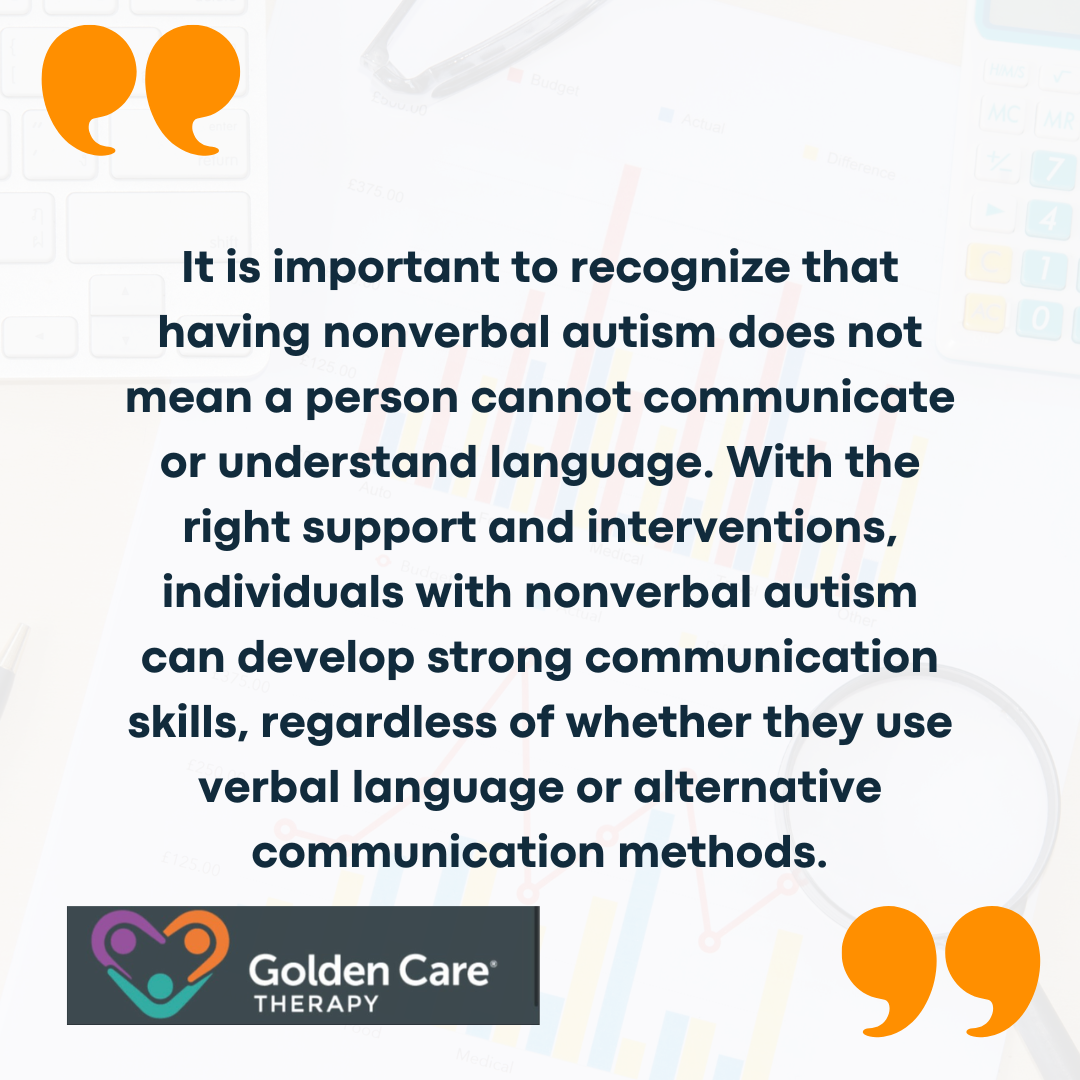Research suggests that approximately 1 in 4 children and teens with autism who are minimally verbal understand significantly more language than they are able to produce.
This finding emphasizes the importance of supporting language comprehension development in individuals with nonverbal autism.
It is important to note that understanding language is often a stepping stone to producing language. Without understanding the meaning of language, it becomes challenging to produce spoken language. While individuals with nonverbal autism may face difficulties in speech production or motor planning, many of them can still understand spoken language in different ways.

Motor and Social Skills Impact on Language
Motor and social skills play a significant role in the language development of individuals with nonverbal autism.
Challenges in motor skills, such as fine motor control, can affect their ability to produce spoken language. Difficulties in social skills may also impact their ability to engage in meaningful conversations and interactions.

By understanding the language comprehension abilities of individuals with nonverbal autism and recognizing the impact of motor and social skills, we can provide the necessary support to help them reach their full potential in communication and language development.
Language Development in Nonverbal Autism
Language development in individuals with nonverbal autism is a complex and unique journey. While they may face challenges in speech production or motor planning, it’s important to understand that their ability to comprehend language can vary significantly.
Receptive vs. Expressive Language Skills
When discussing language development in nonverbal autism, it’s essential to differentiate between receptive and expressive language skills.
Receptive language refers to the ability to understand and comprehend spoken or written language. Expressive language, on the other hand, pertains to the ability to produce and express oneself using spoken or written words.
While some individuals with nonverbal autism may struggle with expressive language skills, research has shown that around 25% of children with autism and low verbal skills demonstrate better receptive than expressive language skills. This indicates that although they may not be able to speak, they can still understand what is being said to them.
Importance of Understanding for Language Production
Understanding language is often a stepping stone to producing language. Without a solid comprehension of the meaning behind words and sentences, it becomes challenging to effectively express oneself verbally.
For individuals with nonverbal autism, supporting their language comprehension can be instrumental in facilitating their overall communication abilities.
Many children with nonverbal autism have the capacity to understand spoken language in various ways, even if they struggle with expressing themselves verbally. This understanding can be facilitated through visual supports, gestures, or alternative communication methods.
By focusing on enhancing their receptive language skills, caregivers and therapists can provide a strong foundation for future language production.
It’s important to note that having nonverbal autism does not mean a person cannot communicate or understand language. With the right support and interventions, individuals with nonverbal autism can become strong communicators, regardless of whether they utilize verbal language or alternative forms of communication.

Communication Strategies
There are various strategies and techniques that can be helpful for supporting individuals with nonverbal autism. Let’s look at the two most commonly used approaches.
Alternative Communication Methods
Alternative communication methods, such as Augmentative and Alternative Communication (AAC) devices, can play a vital role in helping individuals with nonverbal autism express themselves and establish stronger connections with their loved ones.
AAC devices are tools that can range from simple picture boards to high-tech devices with speech output capabilities. These devices enable individuals to communicate their needs, desires, and thoughts in a nonverbal manner.
Using AAC devices can significantly enhance the quality of life for individuals with nonverbal autism. It allows them to actively participate in conversations, share their ideas, and engage with others, promoting a sense of independence and self-expression.
Sign Language
Sign language is another powerful communication method that can greatly benefit individuals with nonverbal autism. It provides an avenue for expressing thoughts, emotions, and desires through manual gestures and movements.
Parents can introduce their child to a formal sign language system, such as American Sign Language (ASL), or create a unique system of gestures tailored to their child’s needs and abilities.
Learning sign language can enhance communication skills, foster social interactions, and facilitate the understanding of abstract concepts.
Sign language can be particularly effective for individuals with nonverbal autism who may struggle with spoken language but have the motor skills necessary for producing signs. It offers a visual and kinesthetic approach to communication, aiding in comprehension and expression.

Effective Communication Tips
Apart from the strategies mentioned above, there are also certain strategies that can greatly enhance understanding and connection among individuals with nonverbal autism.
These are as follows:
Repetition and Processing Time
Communication with individuals who have nonverbal autism often requires the repetition of important information. By repeating keywords and phrases multiple times, you can increase the chances of comprehension and retention.
It’s important to be patient and allow the child sufficient time to process the information before expecting a response.
In addition to verbal repetition, using visual aids and gestures can also be helpful. Showing the child how to perform certain actions by demonstrating them yourself can reinforce the meaning behind the words being used. This multisensory approach can facilitate better comprehension and communication.
Understanding Nonverbal Signals
Nonverbal signals play a crucial role in communication, especially for individuals with nonverbal autism. Understanding and interpreting nonverbal cues such as body language, facial expressions, and tone of voice can provide valuable insights into the emotions and needs of the individual.
Even if a child with nonverbal autism struggles with making eye contact or displaying typical facial expressions, it’s important for parents and caregivers to pay attention to other nonverbal cues. These cues can provide clues about the child’s well-being, comfort level, and level of engagement.
By closely observing and interpreting nonverbal signals, parents and caregivers can better understand the child’s communication attempts and respond accordingly. This can foster a deeper connection and create a supportive environment for effective communication.
Remember, effective communication with individuals who have nonverbal autism requires patience, understanding, and a willingness to adapt to their unique communication styles.
By implementing strategies like repetition and processing time, and being attuned to nonverbal signals, parents and caregivers can enhance their ability to connect with and support their child with nonverbal autism.
Research continues to shed light on the neurological basis of sensory issues in autism, offering hope for more targeted and effective therapies in the future. By recognizing and addressing sensory processing difficulties, we can improve the quality of life for individuals with autism and their families. If you’re seeking specialized ABA therapy in New Jersey, Indiana, Georgia, and New York, Golden Care offers comprehensive services tailored to meet the unique needs of each individual. Contact us to learn more or book a consultation today.
Sources:
https://www.medicalnewstoday.com/articles/non-verbal-autism
https://getgoally.com/blog/can-my-child-with-nonverbal-autism-understand-me
https://medicalxpress.com/news/2023-05-kids-nonverbal-autism-spoken-language.html



